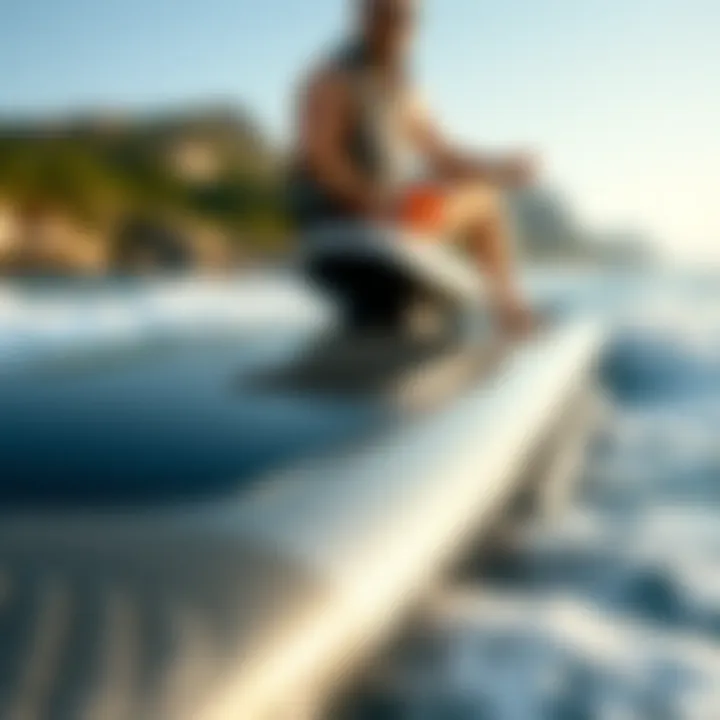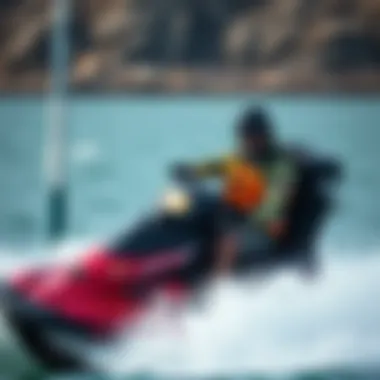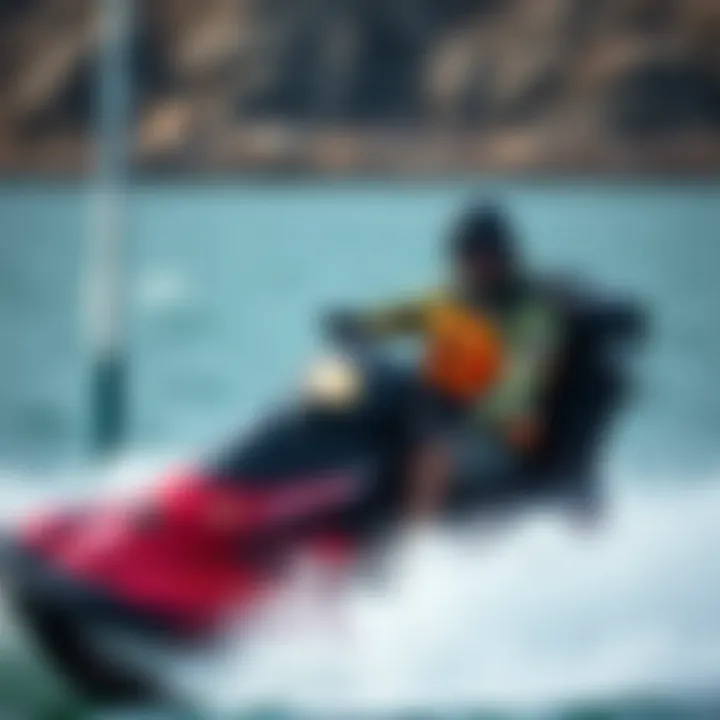Electric Jet Body Boards: The Future of Water Sports


Intro
Electric jet body boards are capturing the attention of water sports enthusiasts around the globe, pushing the boundaries of how we engage with our oceans and lakes. Imagine gliding effortlessly over waves, propelled by a silent motor, navigating through the water with a sense of agility that's often reserved for more traditional sports. These boards are not merely a novelty; they represent a significant shift in water sports, offering a blend of fun, adrenaline, and unique experiences for riders of all skill levels.
This article seeks to investigate the nuances of electric jet body boards, focusing on their evolution, design variations, and performance metrics. We'll dissect what makes these boards tick, the fascinating technology behind their operation, and the advantages they offer over conventional bodyboarding. Moreover, consideration will be given to safety aspects and maintenance needs—essential knowledge for anyone keen on getting started or upgrading their current equipment.
The appeal of electric jet body boards goes beyond their functionality. They encourage a new theatre for exploration outside of traditional spots, fostering a fresh culture in water sports. Whether you’re on the shore of a bustling beach or an idyllic lake hidden away from the chaos, these boards invite adventure and discovery. As we venture deeper into this realm, we will share insights, tips, and trends that are shaping the future of this exhilarating sport.
Let's gear up and dive deeper into the specifics, discovering how these boards are revolutionizing water play and what you need to know to join in on the excitement.
Intro to Electric Jet Body Boards
Electric jet body boards represent a distinctive shift in the domain of water sports, blending traditional riding experiences with modern technology. This transition has not only reshaped how enthusiasts interact with water but also elevated the accessibility and enjoyment of a myriad of water environments. As these innovative boards become increasingly prevalent, it prompts a reevaluation of established practices and opens the door to fresh adventures for both seasoned riders and newcomers alike.
The relevance of electric jet body boards lies in their ability to democratize the sport. Riders previously hindered by physical limitations or a lack of experience now find opportunities to engage in an exhilarating pastime. Imagine a family at a beach, where a child with limited swimming ability can glide effortlessly across waves, or someone with mobility challenges who can now participate in thrilling water activities. This inclusive approach is significant, making the sport more inviting to various skill levels.
When considering safety, operational ease, and enjoyment factors, electric jet body boards shine. Riders can traverse larger distances with less physical strain while enjoying enhanced stability and performance through technological improvements. With battery life extending and motors becoming more efficient, these boards promise longer rides without the need for frequent breaks, offering an ascending experience.
Moreover, as we delve into this article, it's vital to appreciate how electric jet body boards are not merely tools but symbols of innovation that reflect broader trends in sustainable technology. Using electric propulsion rather than fossil fuels aligns with a growing trend toward eco-friendliness in sports, which appeals to a conscious consumer base.
By examining the various facets of electric jet body boards, we explore:
- Their definitions and how they differ from traditional board sports.
- The historical background of water sports leading up to this modern invention.
- The cutting-edge technology behind their design and performance.
Through this exploration, we hope to provide an engaging narrative for kiteboarders, instructors, travelers, adventurers, and hobbyists who seek not just a thrilling ride but also a deeper understanding of this exciting evolution in water sports.
"Innovation is the key to unlocking new realms of enjoyment, turning traditional pastimes into extraordinary adventures."
As we proceed through the article, keep in mind how electric jet body boards are more than just the latest gadget—they’re a gateway to a changing culture in outdoor recreation.
Technological Innovations
The rise of electric jet body boards marks a pivotal turn in the landscape of water sports. Understanding the technological innovations behind these devices not only highlights their appeal but also underscores their impact on user experience and performance. As these advancements unfold, they elevate the sport to new heights, making it accessible and enjoyable for both seasoned kiteboarders and adventurous newcomers.
Battery Technology Advancements
One of the keystones of electric jet body boards is the advancements in battery technology. Modern boards, like those from brands such as JetSurf and Radinn, utilize lithium-ion batteries that boast a great balance of weight and power. This allows riders to experience longer sessions on the water without being tethered to a power source. Moreover, the rapid charging capabilities mean less time waiting by the docks and more time carving through the waves. The development of integrated battery management systems ensures optimal usage, prolonging battery life and ensuring safety.
- Lightweight energy density: Current battery tech offers a higher energy density, making them lighter yet powerful enough to sustain high speeds.
- Rapid charging: With innovations in battery chemistry, users can experience quick turnaround times between runs, enhancing convenience for riders on the go.
"The enhancement in battery technology is not just about powering the board; it’s about empowering the rider with freedom on the water."
Motor Efficiency and Performance
When it comes to the heart of electric jet body boards—the motor—the focus is on efficiency and performance. Advanced brushless motors are standard now, providing a quieter experience while drawing less power. This shift not only improves performance but also extends ride time. Brands like Lampuga have integrated smart torque controls, allowing riders to adjust power output based on their desired speed and style. This adds a layer of personalization, enabling everyone from casual cruisers to thrill-seekers to find their sweet spot.
- Smooth acceleration: Well-designed motors ensure gradual acceleration, providing a gentler introduction to speed.
- High thrust-to-weight ratio: Modern motors maximize output, delivering exhilarating speed without compromising on stability or control.
Control Systems and User Interface
The user interface of electric jet body boards has undergone significant transformation, offering riders intuitive control systems that enhance the overall experience. Most boards now feature wireless remotes or wrist controls, allowing users to manage speed and direction effortlessly. This intuitive setup not only helps in learning but also in executing tricks, making it easier to navigate various water conditions.
- User-friendly displays: Many boards come equipped with digital displays that provide real-time information, such as speed, battery status, and ride time, empowering riders to keep an eye on their performance metrics.
- Smart connectivity: Integration with smartphones allows riders to customize settings and download firmware updates, ensuring their board is always in line with the latest technological enhancements.
these technological innovations are reshaping what riders can achieve on the water. The combination of battery technology breakthroughs, efficient motors, and smart control systems ensures that electric jet body boards not only provide a thrilling experience but also open up a wider audience to the joys of water sports.


Design Variations
Electric jet body boards have carved a unique niche in the realm of water sports, and one significant factor contributing to this evolution is the myriad of design variations. These variations not only enhance performance but also allow riders the freedom to express individuality and personal taste. Understanding the specific elements that shape these designs can illuminate their impact on usability and experience.
Materials Used in Construction
When it comes to crafting electric jet body boards, the choice of materials is paramount. The materials not only determine durability and weight but also influence the buoyancy and maneuverability of the board on water. Most boards are constructed using a combination of high-density foam and fiberglass, which provide a lightweight yet sturdy structure. This balance is vital; a well-made board should withstand the rigors of waves while remaining light enough for agile navigation.
In recent innovations, manufacturers have begun employing carbon fiber and other composite materials to push the envelope further. These materials are prized for their strength-to-weight ratio and can significantly improve performance and handling. Also worth noting is the growing trend towards using eco-friendly materials, appealing to environmentally-conscious riders. These options can enhance sustainability while ensuring that riders enjoy top-tier performance.
Key Materials to Consider:
- High-density foam
- Fiberglass
- Carbon fiber
- Recycled or eco-friendly composites
Size and Shape Considerations
The size and shape of electric jet body boards can make or break the riding experience. A rider's weight, skill level, and intended use all play a crucial role in determining the ideal specifications. Larger boards, often characterized by their wide surface area, offer great stability and are generally more beginner-friendly. Conversely, smaller, sleeker boards provide increased maneuverability and performance but require more skill and balance to handle effectively.
Riders must also consider the shape of the board's hull. Designs with pronounced rocker can help in achieving better lift and carving on waves, whereas flatter hulls might lend themselves to high-speed straight-line riding. Ultimately, understanding these dynamics enables riders to choose a board tailored to their specific needs, significantly enhancing their enjoyment on the water.
Aesthetic Options and Customizations
A significant selling point of electric jet body boards lies in their aesthetic appeal. The options for customization are virtually limitless, allowing riders to align their board’s look with their style. From vibrant color schemes to intricate graphics, the visual aspects are just as important as performance features. Many manufacturers offer customization through wraps or paint jobs, enabling individuals to express themselves uniquely.
Furthermore, brands are also investing in personalized design options, where customers can select patterns, colors, and even add personal insignias or names to their boards. This kind of engagement creates a deeper connection between the rider and their equipment, adding an emotional layer to the experience.
- Customization options may include:
- Color choices
- Graphic designs
- Personal insignia or name
Operation of Electric Jet Body Boards
The operation of electric jet body boards is a pivotal aspect of understanding how they are changing the landscape of water sports. Being able to effectively manage these high-tech boards isn’t just about having fun; it’s crucial for ensuring safety, maximizing performance, and truly appreciating the new dimensions they add to the sport. With advances in motor technology and battery efficiency, the impact on how riders interact with the water is profound. Riders need to know how to operate these boards proficiently to enjoy their experiences fully, which is why this section dissects the essential procedures from start to finish.
Starting and Stopping Procedures
Starting an electric jet body board requires a few straightforward steps. First off, it's key to check the battery level, as no one wants to find themselves stranded mid-session. To start, ensure that the board is on a stable, dry surface. Locate the power button, usually positioned near the control handle. Once powered on, it is vital to conduct a systems check. This includes verifying that the control system is responsive and that the propulsion mechanism is free from obstructions.
When it's time to get rolling, riders simply need to press the accelerator trigger once they are in water depth sufficient to avoid damage to the board. The throttle control is typically intuitive but practicing gradual acceleration can prevent jerky movements and give new riders better handling. Stopping can be done by easing off the throttle, allowing the board to coast gently before coming to a halt. In some models, a simple button press can engage a safety stop, which immediately cuts off propulsion, perfect for emergencies.
"Starting and stopping your electric jet body board seamlessly integrates into your riding experience; mastering it opens up the board’s full potential."
Navigating Different Water Conditions
Navigating water conditions can be a tricky ordeal. Different environments—be it choppy waves, glassy lakes, or turbulent rivers—demand different riding techniques. Electric jet body boards allow flexibility in handling but knowing how to respond to various water scenarios isn’t merely beneficial; it's essential for safety and enjoyment.
When riding in choppy waters, leaning slightly forward can help maintain balance, while in calmer conditions, a more relaxed stance is advisable. Choppy conditions might also call for shorter speeds with quicker turns, enabling better control over potential splashes and waves.
Conversely, glassy waters offer an exhilarating chance for speed. Riders can utilize the jet propulsion’s full potential and let the board glide effortlessly across the surface. However, be cautious of sudden shifts in the wind, which might create unexpected ripples.
Riders should always be mindful of their surroundings, keeping an eye out for boats, buoys, and other obstacles. Using a buddy system—or at the very least keeping people informed of your plans—can heighten safety while on the water.
Safety Measures During Use
Safety is paramount when using electric jet body boards. While the thrill rides can be heady, it’s important not to overlook the risks involved. Firstly, always wear a proper flotation device. Besides being a requirement in many places, life jackets or buoyancy aids provide that extra sliver of security against unexpected situations. Additionally, wearing a helmet can be wise, especially for riders who are beginners or those looking to push the envelope.


Understanding how to operate the board comes along with knowing how to respond in emergencies. Practicing how to shut off power quickly can save a rider from an unwanted spill; having that knowledge in the back of one’s mind offers peace of mind regardless of skill level.
Moreover, being conscious of the weather is another key point. Avoid heading out during storms or when high winds are present, as both could make even an experienced user struggle with control. By staying within the limits of one's ability and knowing the board’s capabilities, the experience can be thrilling while remaining grounded in safety practices.
By mastering the essential operational aspects of electric jet body boards—from starting procedures to navigating various water conditions and adhering to safety measures—riders can truly enhance their water adventures. The thrill of riding these boards awaits, but doing so responsibly ensures that joy is shared, and injuries are minimized.
Benefits of Electric Jet Body Boards
Electric jet body boards have stirred quite the excitement among water sports enthusiasts. While the thrill of riding the waves is undeniable, these boards offer a blend of performance, accessibility, and environmental consciousness that sets them apart from traditional methods. Let's explore the significant advantages they bring to the table.
Accessibility for Various Skill Levels
One of the most compelling aspects of electric jet body boards is their ability to cater to different skill levels. The innovative design and technology behind these boards allow anyone—whether you're a novice trying their luck or a seasoned pro—to enjoy the water with ease. For example, beginners benefit from stability features and simplified controls, allowing them to focus on riding rather than struggling with awkward maneuvers. Meanwhile, experienced riders can tap into advanced settings to fully utilize the board's power for exhilarating speeds and tricks.
This level of accessibility transforms what was once a niche sport into a mainstream hobby enjoyed by families, friends, and solo adventurers alike, contributing to the growing popularity and acceptance of electric jet body boards.
Sustainability and Eco-Friendliness
In a world increasingly concerned with the environment, electric jet body boards offer a more sustainable alternative to gas-powered watercraft. These boards operate on electric power, drastically reducing noise pollution and emissions often associated with traditional water sports. For those who are environmentally conscious, using an electric jet body board aligns with a commitment to protecting our oceans and waterways.
Moreover, many manufacturers are now focused on using recyclable materials and sustainable practices in their production processes. Thus, riders can enjoy the thrill of the waves while feeling good about their environmental impact.
"Riding an electric jet body board is not just about the fun—it's also about being kind to Mother Nature."
Enhanced Experience and Adventure
Electric jet body boards deliver an adrenaline rush that simply cannot be matched. Riders can quickly dart across the waves, explore coastal areas that might otherwise be inaccessible, or even catch a ride on wind-driven swells. The versatility of these boards means you can tailor your experience—fly solo or partake in group rides, all while discovering the lush beauty of marine environments.
In addition, the ability to control speed and direction allows for a more personalized adventure. From quiet paddling to high-speed thrills, riders have the freedom to go at their own pace. Thus, whether you’re looking for a peaceful jaunt or a high-octane joyride, the electric jet body board has it all.
In summary, the benefits of electric jet body boards are numerous and varied, making them an attractive option for all kinds of water sports lovers. They democratize the sport, promote eco-friendliness, and enhance the overall experience, cementing their place as a revolutionary advancement in water-based activities.
Market Trends and Popularity
As the watersports landscape continues its dynamic shift, electric jet body boards are at the forefront of a popular wave, drawing enthusiasts from various backgrounds. Understanding the market trends and popularity surrounding these devices is crucial for those interested in water sports, particularly for kiteboarders, instructors, travelers, and hobbyists. This segment explores key elements impacting consumer choices and how these trends are shaping the recreational watersports industry.
Growth of Electric Water Sports
The emergence of electric jet body boards is leading to a significant surge in electric water sports. Unlike traditional boards, these innovative devices offer an exhilarating experience, allowing riders to glide over water effortlessly. The growth can be attributed to several factors:
- Technological Advancement: Ongoing improvements in battery life and motor efficiency mean that electric jet boards can now operate longer and more efficiently. With power sources that promise increased ride times, users can spend more time on the water.
- Increased Accessibility: As these boards become more user-friendly, novice riders can hop on without needing extensive training. This has opened the floodgates for new participants in previously niche markets.
- Environmental Consciousness: Electric boards are more sustainable compared to gas-powered alternatives, attracting environmentally-conscious consumers. Many riders appreciate being able to enjoy water sports while reducing their carbon footprint.
- Enhanced Experiences: With features like remote controls and adjustable speeds, the experience of riding has evolved. Riders can customize their thrill levels, fitting varied preferences and increasing appeal.
These dynamics foster a greater sense of community among users, leading to more organized events and competitions, thus fueling the growth of electric water sports.
Demographic Insights
Understanding demographic insights is essential for comprehending the trajectory of electric jet body boards. Companies are consistently gathering data on who is buying these boards and why, and this information is corner-stoning new innovations and marketing strategies. Several demographic trends stand out:
- Age Range: Electric jet body boards are not restricted to the young. From teenagers to older adults, the appeal spans multiple generations, allowing family-friendly activities.
- Location: Coastal areas and lakeside communities have witnessed the highest uptake. Regions with warm climates and strong water sports cultures are particularly influential in driving demand.
- Income Levels: The initial investment in electric jet boards may be steep, but the growing market is catering to various price points, making them accessible to a wider audience. Some brands offer entry-level models that reduce the barrier to entry.
- Adventure Seekers: Those with a penchant for adventure, including travelers and thrill-seekers, tend to gravitate toward electric jet boarding. They are willing to explore new watersport experiences, making them a core market segment.
In summary, the statistics and trends shed light on a vibrant marketplace pivoting toward electric water sports. By recognizing who the consumers are and why they engage with these products, the industry can not only adapt but also thrive in an ever-evolving landscape.
Understanding shifts in market dynamics will be key for brands and riders alike as the electric jet bodyboarding revolution continues to gain momentum.
For further detailed insights on water sports trends and their influence on the market, refer to sources like Wikipedia and Britannica.
Comparative Analysis with Traditional Bodyboarding
The rise of electric jet body boards marks a notable shift in the world of water sports, stirring curiosity among both seasoned enthusiasts and newcomers alike. Understanding how electric options stack up against traditional bodyboarding is essential for anyone looking to make an informed decision in their water adventures. This comparative analysis shines a light on vital distinctions, challenges, and overall experiences between the two, stirring a deeper appreciation for both methods of riding the waves.
Differences in Technique and Skillset


When it comes to technique, using electric jet body boards requires a different skillset compared to traditional bodyboarding. The fundamental aspect of paddling to catch a wave, a hallmark of traditional bodyboarding, shifts to maneuvering controls on an electric board. With electric boards, users can start riding without the need for constant paddling.
- Control Mechanisms: The control interfaces on electric boards often include a simple throttle control. Riders accelerate by easing down on a button, which contrasts with the more intensive paddling method of traditional bodyboarding.
- Stability and Balance: Electric boards tend to offer more stability, especially for newcomers who might otherwise struggle in turbulent water. Formerly difficult moves become manageable, allowing a broader audience to experience thrills.
- Learning Curve: While the electric boards may seem easier for beginners, mastering the controls can present its own learning curve. Riders need to adjust their balance quickly when the board accelerates. In traditional bodyboarding, the balance adjustments are more intuitive, as they derive from ocean dynamics rather than controlling machinery.
The overall takeaway here is that each method of bodyboarding appeals to different kinds of riders. Enthusiasts of traditional board riding often thrive on the natural challenge of catching waves, while electric boarders relish the thrill of speed and precise control.
Cost Considerations
Cost also plays a pivotal role in deciding between electric jet body boards and traditional options. The financial aspects are multifaceted, impacting initial investment, maintenance, and operational costs.
- Initial Investment: Electric jet body boards can be several thousand dollars, significantly pricier than standard bodyboards that might range between $100 to $500. Considering accessories, like battery chargers and waterproof cases, further inflates the cost.
- Maintenance Costs: Electric models require different upkeep; regular checks on the battery system, motor efficiency, and electronic controls are mandatory to ensure prolonged lifespan. Traditional boards generally just need soap and water cleanings, making them cheaper and easier to maintain.
- Operational Costs: Using electric boards also implies the cost of charging. Depending on where you live, energy costs can add up. If you use the board frequently, these operational costs can’t be ignored, especially compared to the cost-free nature of paddling on waves with a traditional board.
Ultimately, the decision between electric jet body boards and traditional bodyboarding can hinge on personal preferences, budget restrictions, and skill progression aspirations. Both forms offer unique thrills but suit different perspectives on what water sports can deliver.
"The beauty of water sports lies not just in riding, but in the diversity of experience each style offers."
Maintenance of Electric Jet Body Boards
Proper maintenance of electric jet body boards is not just a chore, it's a necessity to ensure longevity and optimal performance. Much like a car needs regular oil checks and tire rotations, these innovative water toys require vigilant care. Neglecting maintenance can lead to performance issues, increased repair costs, and even safety risks while riding. Thus, it’s important for users, whether seasoned riders or newcomers to the sport, to familiarize themselves with essential upkeep practices.
Cleaning and Care Protocols
Maintaining the cleanliness of your electric jet body board can greatly extend its lifespan. Saltwater and sand can be particularly harmful if they are not cleaned off promptly. Here are some vital cleaning and care protocols to follow:
- Rinse after each use: After every session, take your board and rinse it thoroughly with fresh water. Pay particular attention to nooks and crannies where sand may accumulate.
- Dry properly: After rinsing, drying the board is crucial. Use a microfiber towel to wipe it down, ensuring that no water remains on it, particularly around the electrical components.
- Check the battery compartment: Ensure that the battery compartment is clean and dry. Moisture can create a host of problems. Inspect seals for wear and replace them as needed.
Cleaning your board doesn't just keep it looking spiffy; it prevents corrosion and performance issues down the line. Taking these small steps can save a lot of headaches in the future.
Troubleshooting Common Issues
Even well-maintained electric jet body boards can face some hiccups. Knowing how to troubleshoot common issues can save time and prevent further damage. Here are some common problems riders encounter and how to address them:
- Battery not charging: If the board doesn't charge, first check the connections and ensure they are secure. Sometimes, it might be as simple as a faulty extension cord or a dead outlet.
- Loss of propulsion: If your jet board isn't moving as it should, inspect the propeller for debris. A simple cleaning can often resolve performance issues. If it still doesn’t work, checking the motor connections is a smart next step.
- Water leaking in: If you notice water inside the battery compartment, immediately inspect the seals and gaskets. These should be intact and clean. If damage is visible, replace them quickly to avoid more severe damage to the board.
Addressing these anomalies promptly can keep your adventures running smoothly and safely. Familiarizing yourself with the common issues and solutions helps you be prepared.
Storage Recommendations
Proper storage is critical for the health of your electric jet body board. Improper storage can lead to damage that could render your gear unusable. Here’s how to store it correctly:
- Indoor storage: Ideally, keep your board in a cool, dry place away from direct sunlight. This reduces the risk of heat damage and fading. A dedicated storage rack or wall-mounted holder can be effective.
- Avoid extreme temperatures: Never expose the board to extreme temperatures, whether hot or cold. These can affect the battery and materials.
- Store the battery separately: For longer-term storage, it's advisable to remove the battery. Store it in a cool space and ensure it's charged to the manufacturer's recommended level before storing.
Future Prospects in Electric Jet Body Boards
The electric jet body board industry is on the verge of an exciting transformation. As technology continues to advance, the implications for electrified water sports are far-reaching. This discussion underscores not just the current capabilities of electric jet body boards but also their potential evolution in the years ahead. The significance of understanding upcoming trends cannot be overstated, especially for kiteboarders, instructors, travelers, and adventurers who seek new experiences on the water.
Innovative Features on the Horizon
Innovation is the lifeblood of any industry and electric jet body boards are no exception. Key advancements are likely to focus on several features:
- Smart Technology Integration: Expect to see more boards equipped with smart sensors that can analyze rider performance. Feedback systems could provide tips for improvement or even adjust settings based on water conditions and user skill level.
- Modular Battery Systems: Imagine customized battery packs that can be replaced or upgraded with ease. This would not only extend the life of the equipment but also minimize downtime. Quick-change batteries could revolutionize how riders plan their sessions at the beach.
- Eco-Friendly Materials: As environmental awareness grows, manufacturers are motivation to find more sustainable materials for construction. The future may watch boards made from recycled plastics or bioplastics that offer high durability without harming the planet.
- Enhanced Safety Features: Safety can never be an afterthought. Anticipate innovations such as automatic cutoff systems that activate if a rider falls off. These kinds of features are essential for newcomers and can offer peace of mind while riding.
As these technologies emerge, they promise to make electric jet body boards not only more efficient but also more fun and accessible for everyone, from novice riders to seasoned adventurers.
Potential Industry Changes
The landscape for electric jet body boards is likely to shift as these innovations take hold. Manufacturers and riders alike must consider several key aspects:
- Market Expansion: As the technology improves, more enthusiasts are likely to take the plunge. This could lead to a market explosion, with more brands entering the fray, prompting healthy competition and potentially driving prices down. A wider range of options may cater to different skill levels and budgets.
- Regulatory Challenges: With growth often comes regulation. Authorities may implement guidelines governing the use of electric boards, especially in crowded waters or sensitive marine areas. Riders and manufacturers must stay informed to navigate these possible restrictions.
- Community Growth: As popularity increases, so likely will community engagement. Expect more user-driven meetups and events, which can enhance camaraderie among enthusiasts. Social media platforms may host vibrant discussions around the best practices, tips, and experiences associated with electric jet body boards.
- Shifts in Sporting Culture: With advancements facilitating higher speeds and maneuverability, there's a chance that electric jet bodyboarding may redefine how we view water sports. This electrified approach might challenge traditional perceptions of what’s possible on the water.
The future of electric jet body boards is not only about advancing technology but also changing how we approach water sports altogether.
As the industry matures, it will demand adaptability from riders and a keen eye for what’s next. Those who embrace these changes will likely find an enriched experience on the water. Fanatics and enthusiasts must be prepared to ride the wave of innovation that is sure to follow.















